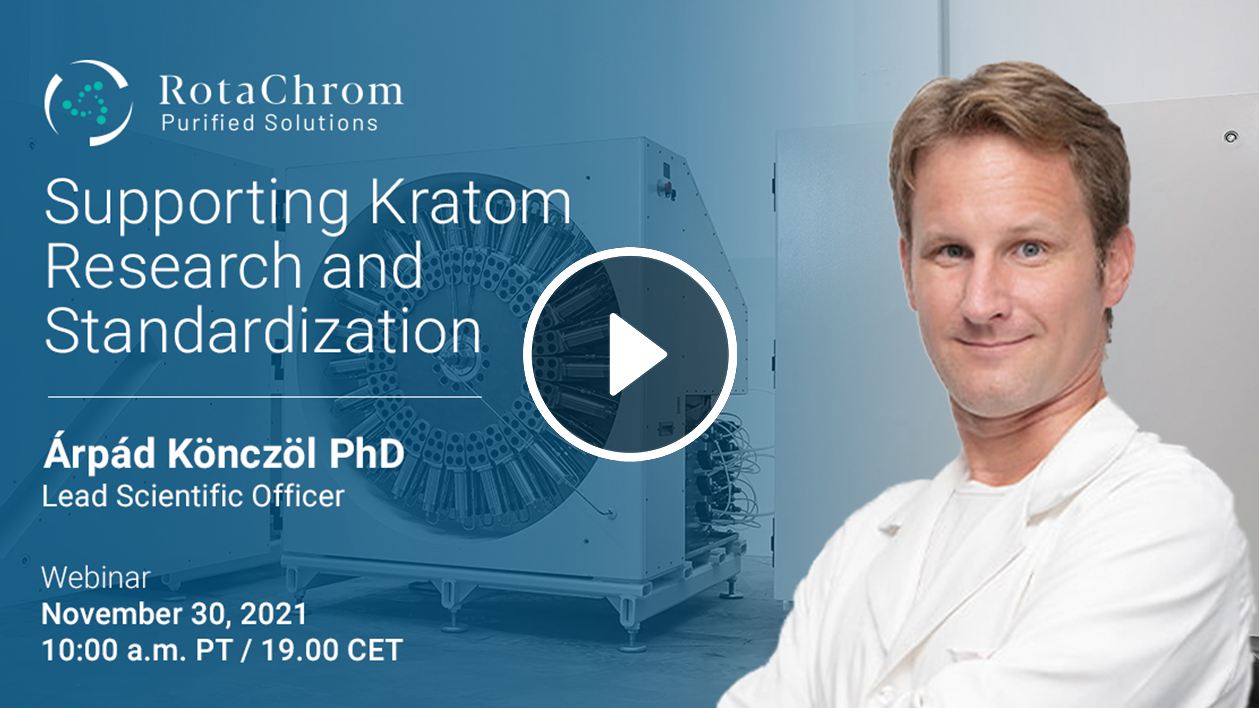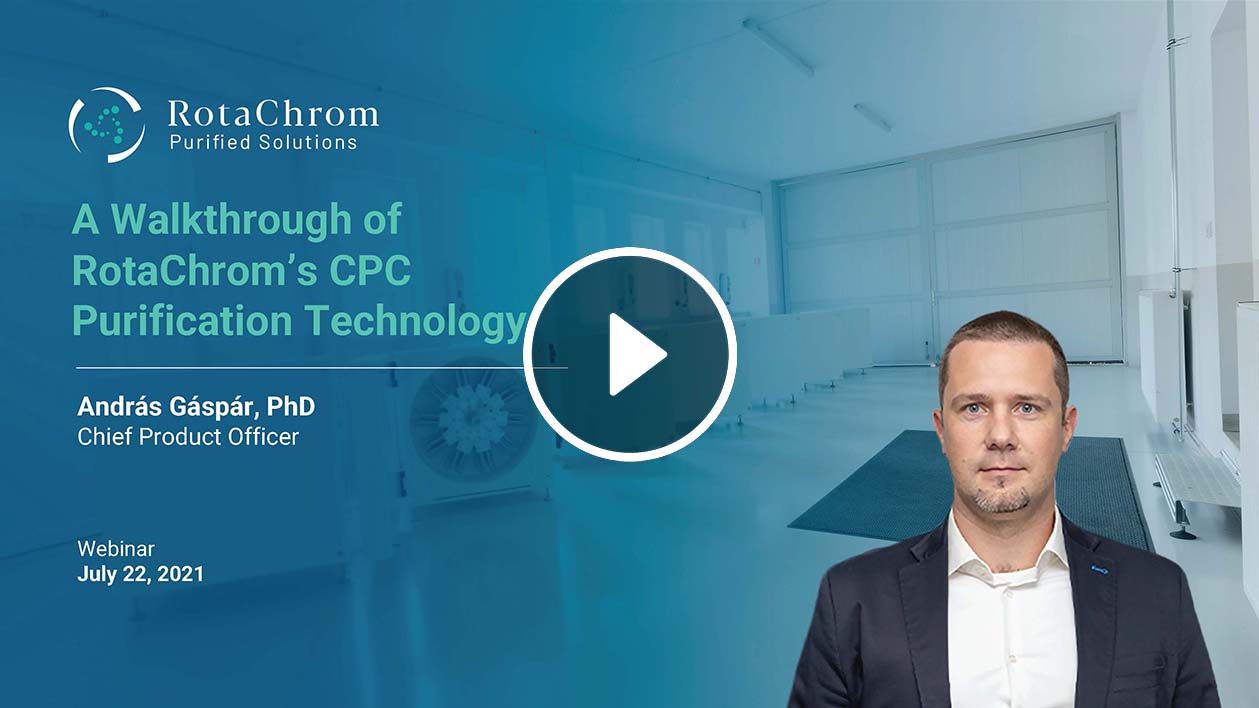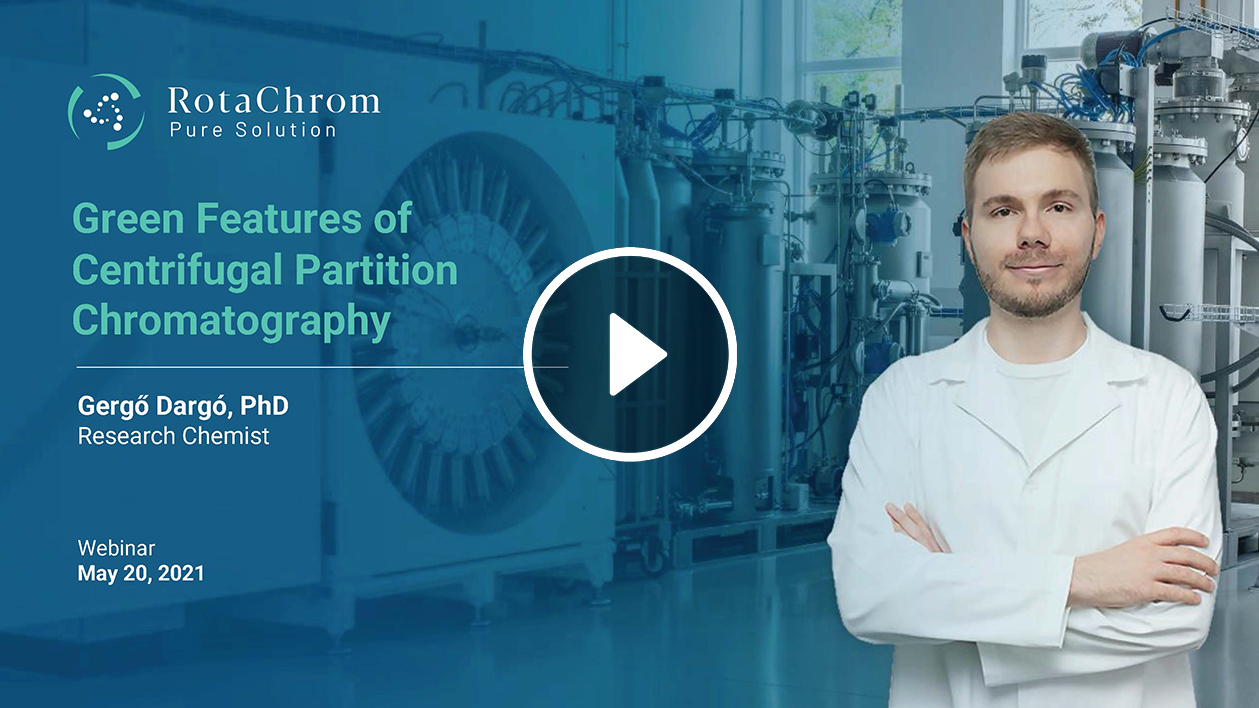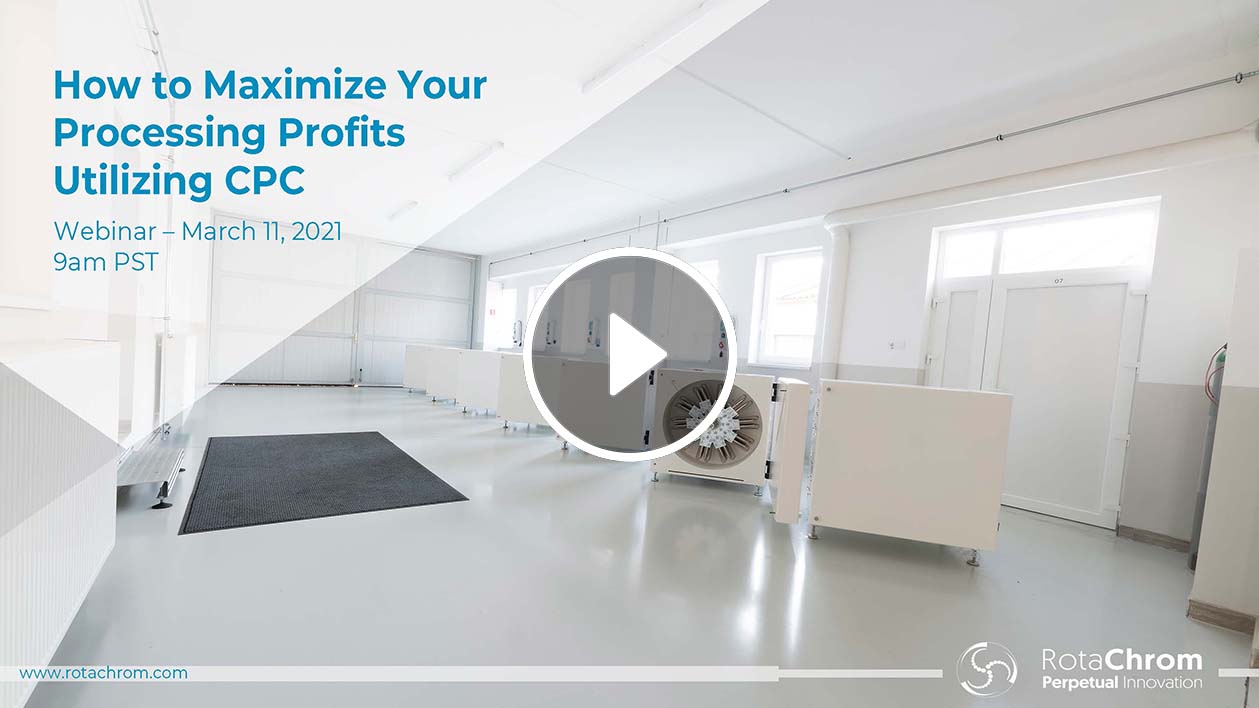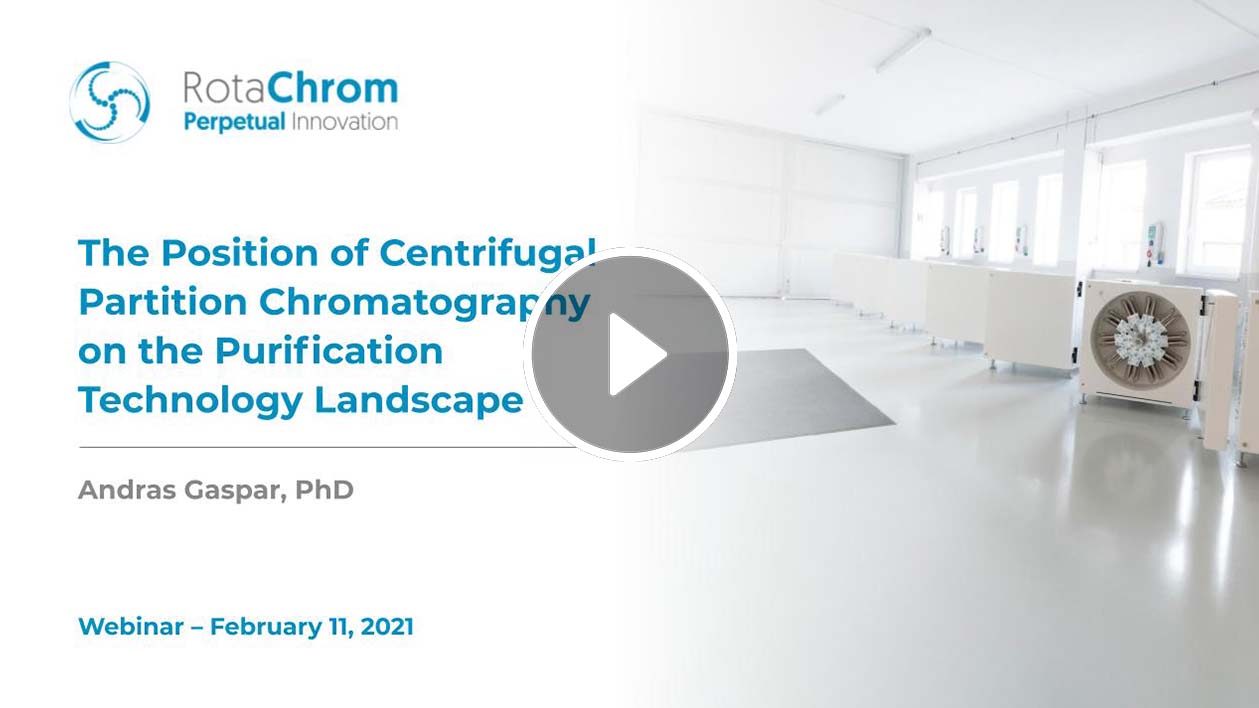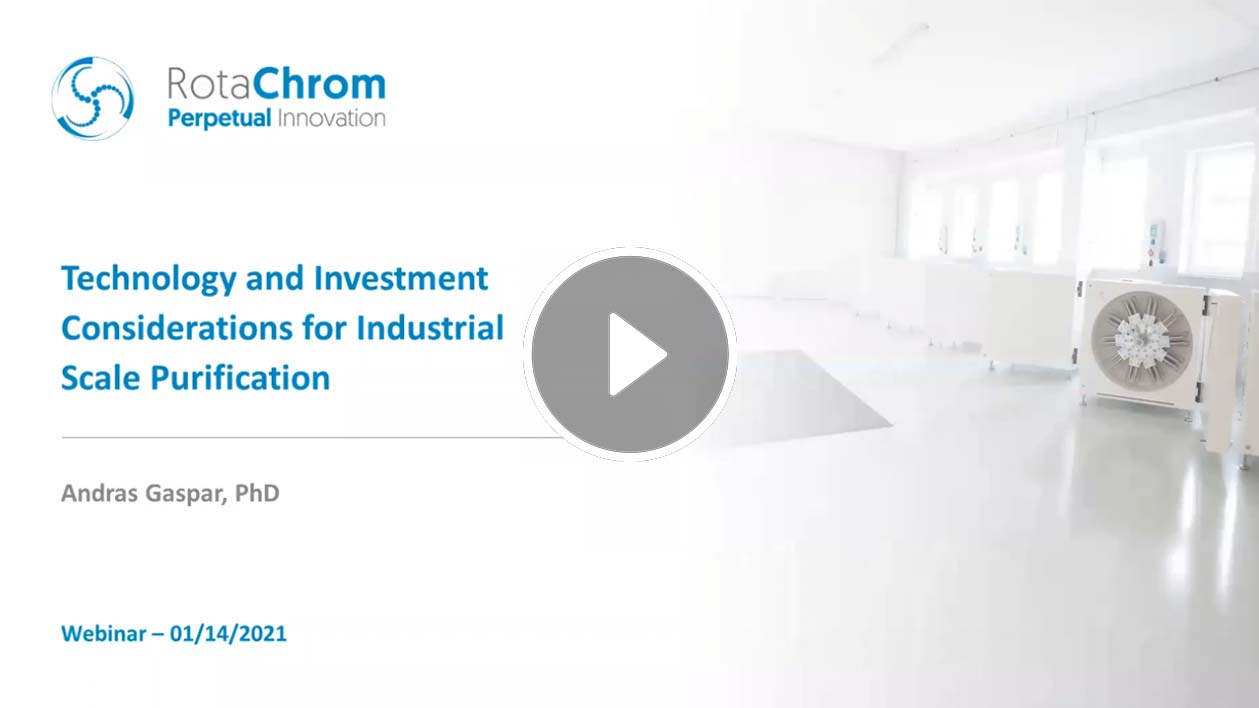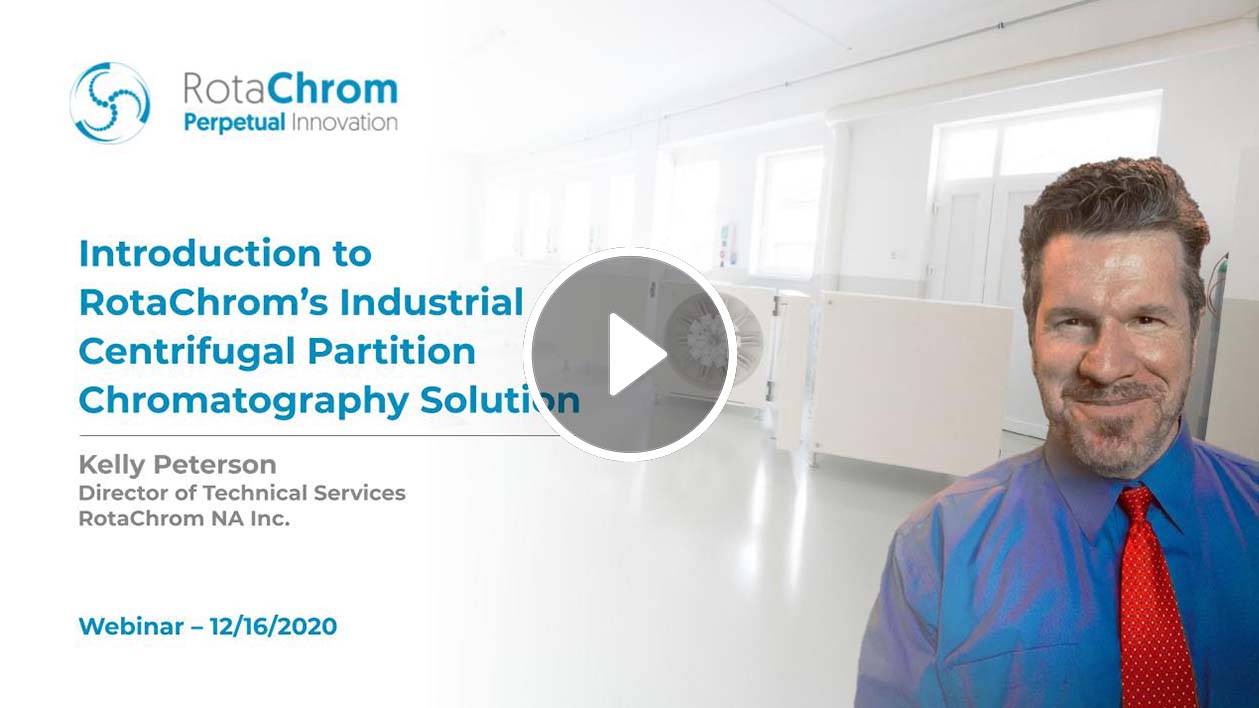Webinar 6 – Green Features of Centrifugal Partition Chromatography
In this webinar, RotaChrom’s Research Chemist Gergő Dargó, PhD discusses the sustainable or “green” aspects of Centrifugal Partition Chromatography purification platforms.
What makes CPC superior to conventional methods when it comes to green chemistry? Because we can refrain from the use of a solid phase in the case of a liquid-liquid system, we avoid purchasing the expensive silica gel and the generation of solid waste and its subsequent disposal costs. In addition, by using liquid-liquid chromatography, a substantial amount of solvents can also be spared compared to solid-liquid systems.
In the case of conventional solid/liquid chromatography methods, there are a limited number of stationary phases that we can choose from, and the replacement of the whole column packing is needed to restore the column to its initial state or to change the type of packing. Therefore, the separation can be fine-tuned by changing the composition of the mobile phase. The risk of clogging and irreversible adsorption might also decrease the time interval of the replacement of the packing. On the contrary, in CPC, an almost infinite number of possible biphasic liquid-liquid systems (BLS) can be chosen using the same column. The possibility of interchangeability of the phases by switching between ascending mode and descending mode also provides great versatility to the system.
In 2007, members of the ACS Green Chemistry Institute® Pharmaceutical Roundtable came to the conslusion that separation and reaction technologies the 2nd most important research fields for increasing sustainability, while solvent selection, recycling and optimization were named the 3rd most important fields of research. This is not surprising, as separation operations are present in almost every manufacturing process within the chemical industry and can be responsible for as much as 70% of the plant cost. Therefore, there is an emerging need for novel, intensified, energy-efficient, and integrated methods to ensure a greener and more sustainable manufacturing process.
From the aspect of green chemistry, it is essential to minimize the ecological footprint of separation steps, which can be achieved by choosing renewable, green solvents and by rigorous management of solvents. A solvent can be considered green if it possesses favorable environmental, health and safety properties. To promote the shift towards the use of greener solvents, several big pharma companies such as Pfizer, GlaxoSmithKline, and Sanofi published their own solvent selection guides. However, these guides offered conflicting classifications and ranked solvents based on different criteria. To remedy this, the Innovative Medicines Initiative (IMI)-CHEM21 consortium created the unified CHEM21 selection guide of classical- and less classical-solvents based on these previous guides, which provided a better ranking comparison of solvents ranking them into “Recommended”, “Problematic”, “Hazardous”, “Highly Hazardous” categories.
Green chemistry design principles can also be employed in the case of several steps of the separation workflow to achieve a significant reduction of costs and ecological footprint. Besides selecting green solvents as components in BLSs, the recycling of waste solvents and waste valorization using CPC are the main areas where CPC can contribute to make the separation greener and more sustainable.
In the past two decades, several steps have been taken to find new alternatives for solvent system components to create greener solvent systems for CPC. To be considered green, these solvents must come from a renewable source, must be relatively non-toxic, and easy to recycle. For safety reasons, it is also preferred that they are non-flammable. Several hazardous solvents used in extractions and chromatography such as n-hexane have already been banned by recent regulations, therefore other alternatives had to be found.
Due to its similar apolar aprotic chemical characteristic, 2-Methyl-Tetrahydrofuran (2-Me-THF) is one of the possible green alternatives to n-hexane in extractions and CPC separations. 2-Me-THF is an easily recyclable chemical, it has low miscibility with water, as well as remarkable stability compared to other heterocycles. It can be produced from renewable raw materials and has a promising environmental footprint and good preliminary toxicology.
Another promising alternative for alkanes in alkane/alcohol/water systems is limonene, which is an apolar natural cyclic monoterpene, with a pleasantly fruity odor. Limonene is a renewable solvent and readily available from citrus peel industrial waste. From a regulatory aspect, the FDA has already listed limonene as a “Generally Recognized As Safe” (GRAS) food additive, flavoring, and fragrance additive. Although it is ranked as a problematic solvent by the CHEM21 guide due to its relatively high boiling point and aquatic toxicity, its natural origin still makes it a better, greener alternative to the problematic/hazardous alkanes hexane and heptane in the HEMWat and Arizona systems. Limonene and heptane are very close in polarity with quite similar solvation capability towards water and methanol (MeOH) resulting in strongly similar ternary plots of the heptane/MeOH/water and limonene/MeOH/water systems. The most prominent difference in their properties is their density difference, which might affect their position in the phases of biphasic systems of the same ratio. In the case of several compositions of the limonene/MeOH/water system, the small density difference between the phases is an advantage for CPC runs, allowing the use of high rotation speed with reduced pressure drop compared to classical alkane-containing systems.
As solvent selection guides marked almost all halogenated solvents as hazardous or highly hazardous, their replacement is also long-desired within the chemical industry. To substitute dichloromethane (DCM) several investigations have been carried out showing that dimethyl-carbonate, tert-butyl methyl ether, 2-Me-THF, cyclopentyl methyl ether (CPME) might be chosen as possible alternatives. CPME has already been successfully used to replace chloroform in high-performance liquid chromatography, and its application in CPC has also been reported as an alternative choice in a new type I. BLS using CPME/dimethylformamide/Water (CDW).
A special group of BLSs, often used in liquid-liquid extractions of proteins and other biomolecules, called aqueous two-phase systems (ATPS). In the ATPS, the phase-forming components, such as two incompatible polymers or a salt (i.e., phosphate, sulphate) and a polymer (polyethylene glycol (PEG)) are dissolved into the safest and most environmentally friendly solvent: water. It has been demonstrated in various cases that the ATPS containing PEG-1000/K2HPO4/Water can be used for CPC separation of proteins (e.g., myoglobin and lysozyme). The use of ATPSs is also looking forward to a bright future in CPC for the purification of biopharmaceuticals. The first attempts in this area showed the applicability of CPC for the purification of three monoclonal antibodies (mAb) from host cell protein (HCP) and in the case of virus-like particles (VLPs).
In recent years, there is a fast-growing interest in the use of so-called Natural Deep Eutectic Solvents (NaDES). Choline chloride (ChCl),which is one of the most widely used hydrogen-bond acceptor components of NaDESs and it also meets the requirements of green solvents being a cheap biodegradable and non-toxic solvent. Among the possible hydrogen-bond donors we can also find environmentally friendly and green components, such as urea, carboxylic acids and polyols. Due to their advantageous solvation capabilities, NaDESs might be used in the future as substitutes for water and BLSs in the case of poorly water-soluble drugs. However, to be considered as truly green solvents, recovery and recycling of the NaDES-constituents must be developed first.
In general, it is also true that the recycling of most of the solvents is desired for a sustainable process whenever it is possible. To this avail, several solutions have been developed such as membrane filtration, ultrafiltration, dialysis, and density-based recirculation (by a mixer-settler) after evaporation. This latest strategy for the continuous in-line recycling of CPC solvents and density measurement-based readjustment of the ternary solvent system has been developed by RotaChrom Technologies. In this automated system, pure solvents are fed into the mixer-settler unit. The solvents system with the desired ratio of solvents is prepared, then its composition is checked by density measurements. The prepared phases are stored in a buffer tank from where they are pumped into the CPC during the chromatographic run. Afterward, waste solvents are separated from the impurities in the recycler skid, then they are fed back into the mixer-settler unit together with evaporated solvents from product fractions. The recirculated phases can be reused in the subsequent CPC cycle after the density-based readjustment of the solvent system. Within the confines of our in-house purification project work, almost 15 kg of crude steroid API was purified in 153 subsequent cycles and high average purity of the compound of interest (98.74%) could be achieved. Using the automated skid system, more than 90% of the organic solvent content of each run of each cycle was successfully recycled and reused.
For more information about green CPC, please visit Rotachrom.com.
WATCH ALL WEBINARS

11-30-21
Supporting Kratom Research and Standardization
7-22-21
A Walkthrough of RotaChrom's CPC Purification Technology
4-15-21
Pesticides Remediation by Centrifugal Partition Chromatography
3-11-21
How to Maximize Your Processing Profits Utilizing CPC
2-11-21
The Position of Centrifugal Partition Chromatography on the Purification Technology Landscape
1-14-21
Technology and Investment Considerations for Industrial Scale Purification
12-16-21
Centrifugal Partition Chromatography on an Industrial Scale
QUESTIONS? GET IN TOUCH!


